Foraging Miner’s Lettuce, America’s Gift to Salad
February 23, 2011 | Updated May 17, 2020
As an Amazon Associate I earn from qualifying purchases.
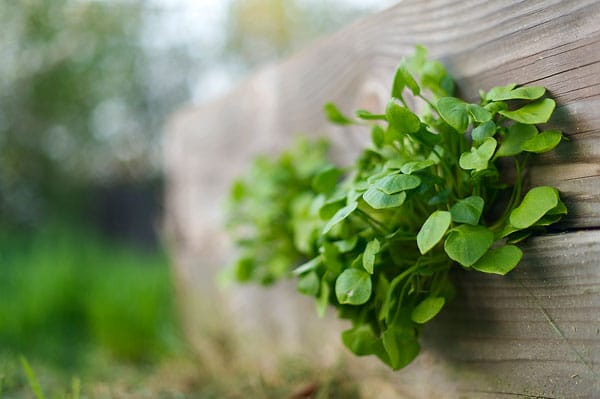
Here in Northern California, our spring comes early. By late February, everything that’s not concrete is green, greener than anything you can imagine. Ireland green. It is the Time of Salads. And no wild salad green is more important than miner’s lettuce, Claytonia perfoliata.
I live near Folsom, and within a mile I saw enough of miner’s lettuce to feed a small town. It is everywhere, so much so that no one can see it. It’s become wallpaper, an anonymous part of the green world we’re enjoying these days. I watched scores of people pass one of the world’s great salad greens without so much as a second glance.
I wonder if they just didn’t recognize the plant in its natural setting? After all, next to blackberries and wild fennel, miner’s lettuce is probably the most recognized wild edible in this part of the country.
Even dazzling urbanites seem to know it, possibly recalling dim memories of summer camps gone by, or of a fancy Alice Waters salad they might have enjoyed at Chez Panisse back in 1989 or something. In gourmet circles, miner’s lettuce has become a commonplace, an afterthought. It is the iceberg lettuce of wild foods.
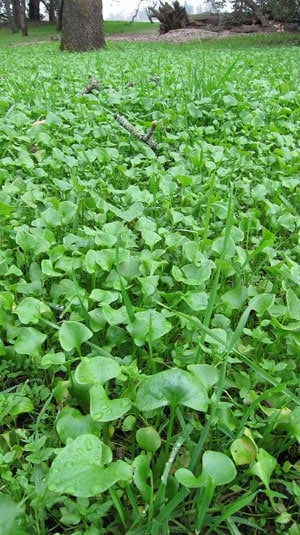
Undeservedly so. Miner’s lettuce is pleasingly crunchy, mild-tasting, has large leaves, remains tender even when in flower, and is so loaded with vitamins it will cure scurvy. The plant got its name because the Gold Rush miners ate it to stave off the disease, which is caused by a Vitamin C deficiency; they learned this trick from the local Indians, no doubt.
According to a study in the Journal of the American Dietetic Association, 100 grams of miner’s lettuce — about the size of a decent salad — contains a third of your daily requirement of Vitamin C, 22 percent of the Vitamin A, and 10 percent of the iron.
Combine this with stinging nettles and you have everything you need to revive your system from a winter’s worth of heavy meats, dried grains and roots.
All of these qualities impressed early explorers so much they saved the seeds of Claytonia perfoliata and brought them back to Europe to grow, first as a curiosity, then as a food plant.
Many sources say this happened in 1749, but I have never found any reference to any original source of this date, which I think is a transposition of the real date the plant reached Europe.
According to Hortus Kewensis, an 1811 catalog of everything growing in England’s famous Kew Gardens, the great Scots naturalist Archibald Menzies discovered miner’s lettuce on the West Coast of America in 1794, not 1749, and he brought seeds back to Kew, where it flourished.
I took a look at Menzies’ journal of the expedition — he was with George Vancouver on Vancouver’s famous round-the-world voyage — and it appears that Menzies actually found the plant along Puget Sound, in current-day Washington, on May 7, 1792:
A little before won the Fog dispersd… we walkd along shore… In this walk I found growing in the Crevices of a small rock about midway between the two points a new Species of Claytonia [a small flowering herb] & as I met with it no where else in my journeys, it must be considerd as a rare plant in this country. I namd it Claytonia furcata & took a rough sketch of it which may be seen in my collections of Drawings.
It is not exactly clear whether this is miner’s lettuce or not, but this is Menzies’ only mention of claytonia in the journals he kept on the voyage, and there are any number of accounts published before 1820 that mark this as the plant’s European provenance.
Miner’s lettuce was so important as a source of Vitamin C that the British planted it in Cuba and, later, in Australia. An early 19th century article I found notes that miner’s lettuce was already well-established in Cuba by 1811, and that it was “spontaneously growing” in the Botanical Gardens of Paris. By mid-century it was being sold by seedsmen as a salad green and potherb — and was rapidly becoming a weed in England.
This is a rare thing. Nearly all our edible household weeds are of European origin: dandelion, plantain, most thistles, chickweed, purslane, mallow, cat’s ear, garlic mustard, shepherd’s purse. For our very own miner’s lettuce to be brought back to Europe, and for it to become a widespread edible weed, is almost unprecedented.
What’s more, miner’s lettuce is one of the very few foods native to North America that we commonly eat.
Think about it: How much of the food in your pantry is native to this place? Wild rice, turkey, cranberries, jerusalem artichokes for sure. Chiles and some squash and beans can qualify, but they are more Central American. Let’s face it, when it comes to the salad course, miner’s lettuce is the king of our indigenous cuisine.
Why it hasn’t become part of our standard “salad mix” is beyond me. It’s ridiculously easy to grow, loves moist shade, and you can buy miner’s lettuce seeds pretty much anywhere. I am growing some this spring, and, like my wild arugula, will be happy to have this little plant colonize my yard.
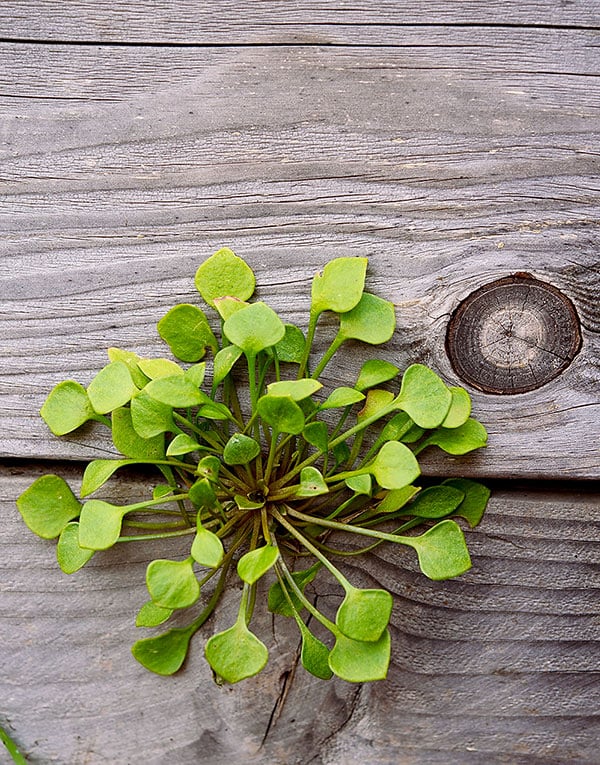
So far as eating miner’s lettuce is concerned, there is really no reason to stray beyond the salad.
This is how most of us enjoy it today, and it’s how the Native Americans ate the plant — although I think I’ll skip the trick performed by a few tribes that lived around Auburn, California: They would apparently strew miner’s lettuce leaves along the highways of a particular kind of ant, which would then excrete something acidic (formic acid, maybe?) on the leaves, flavoring them like vinegar. Weird, eh? I think I’ll stick to vinaigrette.
Normally I mix greens to create certain flavors and textures, but sometimes I prefer to eat miner’s lettuce solo. You really get to know a green when you do this, and you don’t want to dress such a salad too heavily; just a light coating is all.
I made a light mustard vinaigrette for the dressing, and added some fresh ground black pepper and a little flake salt for texture and crunch. The effect is tart, smooth, a little crunchy, and very “green” tasting. Miner’s lettuce is also known as winter purslane (they’re both in the portulaca family) and if you have ever eaten regular summer purslane, you can appreciate the succulent texture of this plant.
For those of you who live anywhere from British Columbia east to the Great Plains, you can find miner’s lettuce, and its various claytonia cousins, in shady, moist spots in spring. According to the USDA, miner’s lettuce has naturalized in a few places east of the Plains, notably Ohio, Georgia and New Hampshire. Pick from February to May, but you will need to find deeper, cooler, places the later you go.
The best leaves grow under trees. Miner’s lettuce is perfectly fine when in flower — unlike most spring greens — but pick before the flower stalk gets too long. Once picked, miner’s lettuce leaves will last in a plastic bag in the fridge for 3 to 5 days without too much loss of quality. Keep a damp paper towel in the bag to keep everything nice and fresh.


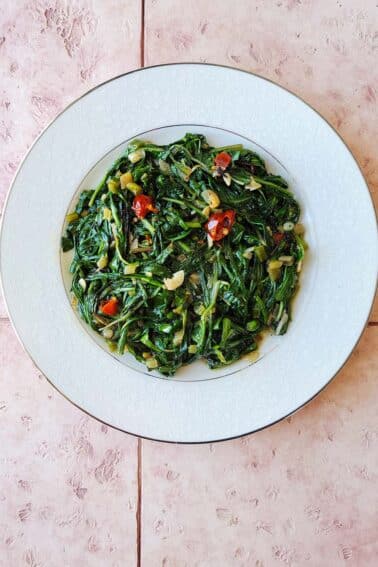

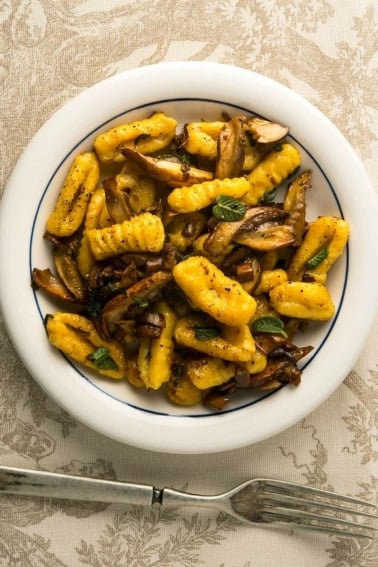
Thank you for the informative article. I just found out what this stuff is. It grows like crazy in my yard, a big tract home in Modesto. I thought it was just some sort of strange weed that is ridiculously easy to pull up. I will try eating some this afternoon. Again, thanks for the article.
I live in Grass Valley and had no idea what this plant was until recently. My friend and neighbor said “wow you have a lot of miner’s lettuce.” The funny thing is it started and then got prolific in our seasonal pig pen ?? After the piggies left of course, and has spread, naturally. Likes good fertilizer obviously.? The new piggies each year love it! Plus now we have plenty that grows OUTSIDE the pig pen.?
I started growing miner’s lettuce in my garden a couple years ago. It took 4 plantings through the growing season before it finally sprouted on the last try in early fall. Since then, I can’t keep it from sprouting in many places, backyard and front. The seeds really do get around. I live in Spokane, WA and our dry, hot summers would seem to make its spread improbable considering its home range is the wet, cool, Pacific coast. However, I was hiking yesterday near Post Falls, Idaho, and I came to a spot right next to the trail where I found several plants.
I grow this lovely green in my hoop house in Nebraska, through the winter. WOW is it a happy little plant! It is coming up this year (after my growing it for the last two) volunteer . . . I hope I don’t regret planting it in there! It sure must have dropped a LOT of seeds last year. Meanwhile, I’m letting it get to a good size and then pulling it up and eating lots of miner’s lettuce salads, and selling bags of it to chefs in the city. Thanks for this informative post!
So I was reading about miners lettuce recipes and most of them have or use different flavors of vinaigrette dressing why ?
Wow who would have thought this beautiful bright green plant that spreads through my 10 acres could feed my whole town! Time to let the homeless in on this little secret. A lady came over yesterday, to drop off a turtle and asked if she could have some. She explained that when she lived in Germany, she used to buy it at the Farmers Market. I’m eating awesome now!!
I just found two miner’s lettuce growing in one of my large blueberry containers. I’ve never had it before, so am pretty excited it ended up in my yard!
I used to live in Walnut Creek, but now am in Southern Oregon, the Rogue Valley. Our climate is pretty much the same, a bit colder in winters.
We have 5 acres in Shingle Springs with large patches of Miners Lettuce in several areas. What a treat.
This is a good season this year as contrasted to last year for the miners lettuce in my area in Martinez. It likes the shady north side of a fence we have. I like to gently rinse it and eat it fresh as is, right after it is picked… needs no dressing in my opinion. Very sweet early in season and once it goes to seed it will have a slightly peppery flavor. ENJOY!
I love Miner’s Lettuce and always have some volunteers around. But today, on a mountain hike, I lifted a few plants from a very prolific bed under some (invasive) broom and brought them home to plant in a raised box near the kitchen. The bed I found was almost mature enough to cut (whereas the volunteers in my garden are still tiny) so I am hoping for some salad next week!
I have a ton of miner’s lettuce growing in my yard in Walnut Creek. Just had a salad with a parmesan vinaigrette, some shaved pecorino romano and croutons. It was delicious!
Yes, it was a bit too early, just like you said!! Now it is like a buffet!
I found it! it was actually just a bit too early before. We have it all over. I just never noticed before! I am so excited, I had my first salad tonight. I started small to be sure I had no reaction. I dressed it with a little olive oil and raspberry vinaigrette with some cracked pepper and sea salt. I also had some dock and chickweed sauteed in garlic and butter. I am in San Juan Bautista and we have it in the woods here mixed in with Chickweed. It is a thick carpet! I just have to be careful because we seem to have a considerable amount of hemlock this year. Thank you so much for this website, you have been my inspiration.
I wish I could find it. I just started actively expanding my foraging menu and have found stinging nettle, lady fern, Curly dock, chickweed, dandelion (of course), malva neglecta but no miner’s lettuce yet. We are in the South Bay? You?
Marianne: I am in the Sierra Foothills near Sacramento. It’s early for miner’s lettuce still.
Thanks so much for this fascinating post. I’ve been munching on Miner’s Lettuce on our Auburn, CA property since I was a child. I learned from my mother that it was edible. Her father was a boy scout leader. I never really took it that seriously. But now I live in Germany and several years ago Miner’s Lettuce started showing up in health food stores. “What? People pay money for this stuff? I have acres of it at home!” I thought. So now I take it seriously. I am visiting my mother and we just had a delicious Miner’s Lettuce salad. Thanks again.
Just picked some for tonight’s dinner of pot roast. I live at 2800 feet in the Sierra foothills, and our miner’s lettuce season is short. But we’re expecting more rain net week and maybe we’ll still have some to pick and enjoy.
Hi. I live in Surrey England. We have had this weed growing under a big tree in the garden for years.
Didn’t know what it was until I took some to the RHS , for identification .
I was told it is Claytonia Perfoliata, Miners Lrttuce. I was surprised to find out it was edible &
How good it was for you. I have now eaten it & it’s good .
Reading this blog has been really interesting
Never knew it existed. Saw it in a book of wild edible plants. Would love to have some seeds.
Have chewed on miner’s lettuce since a small boy and have always loved it. Just pulled one plant from the toe of my compost pile. It will be enough for a big salad for the two of us tonight, its leaves double or maybe even triple the size of all the rest growing on our 5 acres. If my compost pile has nothing else it must have plenty of nitrogen!
My Mothers Back yard is covered with a blanket of green Miner’s Lettuce she have it sprayed 5 years ago do you think the Lettuce is save to eat? they used roundup
Jon: Should be fine. Make sure she doesn’t spray it again though!